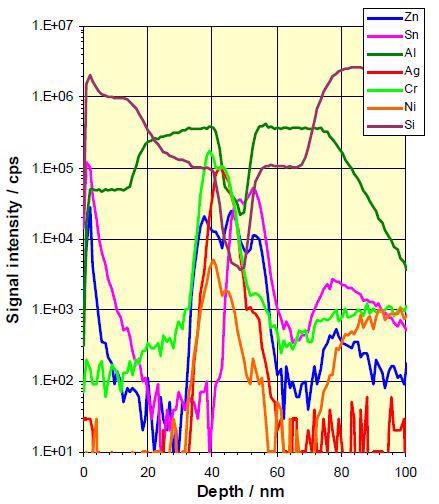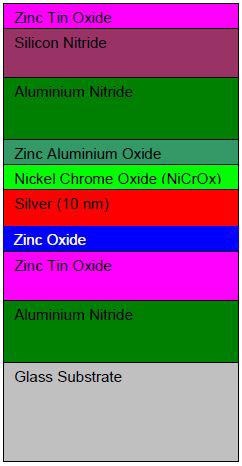Development of glass coatings, that are able to reflect heat (infrared radiation) and allow visible light to pass through with little degradation of perceived clarity or color, is a direct result from the need for energy efficient buildings. The coatings also make it possible to introduce color to the exterior parts of a glass clad building, providing immense possibilities in architectural design.
A layer of sputter deposited metallic silver, measuring just 10 nm thick, is the active part of most low emissivity (low-e) glass. Other dielectric and metallic layers protect the thin layer, creating a layer stack measuring approximately 100 nm thick. Inconsistency in composition or thickness would result in reduced performance and optical difference.
In-situ failure of these layers can be costly, particularly if a large building needs to be reglazed, or if it affects many production units. Failure could be due to; incorrect handling, unsuitable chemicals or a production defect. Secondary ion mass spectrometry (SIMS) is a fast and low-cost analysis tool used for failure analysis and production control. SIMS is able to assess the composition of layers and detect impurities - such as sulfur and chlorine - which can attack and darken the layer of silver.
SIMS
A chemically pure, monoenergetic ion beam of 1-10 keV is used by SIMS to sputter erode the surface being examined. This is followed by studying and detecting ionized secondary particles in the mass spectrometer. Analysis is usually restricted to the top few monolayers at very low ion beam currents, enabling excellent detection of surface contamination. Increasing the ion beam dose results in more aggressive sputtering, revealing deeper layers. Concentration can then be established as a function of depth.
Depth profiles of SIMS are often presented with logarithmic concentration scales, as it is possible to acquire the extreme dynamic range spanning from ppb to bulk in the same analysis. During analysis of insulating samples - like glass, a flood of low energy - electrons are utilized to avoid the buildup of surface charge. In this article, the Hiden SIMS workstation is used to perform the analysis. The SIMS workstation is a versatile quadrupole SIMS instrument, integrated with the MAXIM SIMS analyzer and IG20 gas ion gun. Components are also available individually, allowing the configuration of high performance SIMS on customers existing system such as Auger or XPS, or optimization of the analysis for a specific part of the process flow.
Depth Profile Analysis
Figure 1 shows the SIMS depth profile of a low-e glass sample, acquired using 5 keV Ar ions directed to an 80 µm spot and rastered across an area measuring 400 x 550 µm. A 500 eV electron flood was used to prevent surface charging, and positive secondary ions were collected. The SIMS depth profile suitably agrees with the design specification illustrated in Figure 2.

Figure 1. SIMS depth profile of a low-e glass sample.

Figure 2. SIMS depth profile agrees well with the design specification.
Starting at the exposed surface, the initial layer was very thin and was slightly consumed by the pre-equilibrium area at the beginning of the analysis. Tin and Zinc signals however, are observed at the surface. A high silicon signal can also be seen, which indicates that a thin layer of SiO2 may be present within the area of the ZnSnOx. The layer of silicon nitride is defined by a homogeneous silicon concentration, but this layer also includes aluminum, predicted to be approximately ~7% (atomic). Figure 3 shows an optical image of sample observed through the instrument.

Figure 3. Optical image of sample during analysis as seen by instrument camera system.
A similar thickness of AlN lies below the SiN layer. The Cr signal increases throughout this layer, albeit from three orders of magnitude below the ultimate peak. SIMS is a suitable option for studying this form of low concentration aspect. For the analysis presented, the sensitivity had to be reduced considerably to ensure that the Cr signal peak did not saturate the detector.
The area beneath the AlN includes the thin layer of silver and its thin protective barrier layers, which include Cr, Al, Zn, Ni and O. The width of the NiCrOx layer measures just 1 nm, and during analysis some mixing of the NiCrOx layer in the silver layer occurs. Beneath the silver layer, the thin layers of Zn and ZnSnO can be seen before to the glass substrate and the final AlN layer.
Conclusion
The Hiden SIMS Workstation allows sensitive analysis of depth profiles on glass coatings, exposing layers measuring just a few nanometers in thickness and at the same time determining low concentrations as a function of depth.

This information has been sourced, reviewed and adapted from materials provided by Hiden Analytical.
For more information on this source, please visit Hiden Analytical.